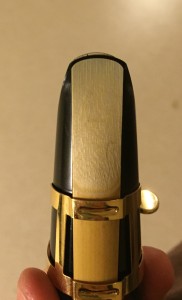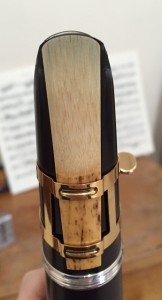Quick Fix Friday: Reed Placement
One of my favorite masterclass moments was when an audience member asked the pedagogue, “What about reeds?” To which he responded, “Yes, reeds are a good idea.”
Reeds are either the best part of our day or the bane of our existence. So many factors affecting reeds are out of our control – humidity, temperature, altitude, full moons, what color socks you wear (just kidding on the last two, but doesn’t it feel that way sometimes?).
There is one thing within your control which can make a huge difference in how well your reeds responds, and that is the reed placement on the mouthpiece. This is highly individual, but a few simple tweaks can result in major differences.
General tips for ideal reed placement:
Make sure your reed is on straight. This is the most important tip (sorry for the unintentional reed pun). If a reed is even a little too far to the left or right, it makes it unbalanced. Thus, one side will be “heavier” than the other (have more cane), so it will be more resistant.
Experiment with raising and lowering your reed to find your ideal placement. How does this work? The heart of the reed (see, reeds aren’t heartless creatures after all!) determines reed strength, and by raising or lowering the reed (and the heart), you are essentially increasing or decreasing reed strength, if only by a small percentage. I use this technique a lot, especially when I have a reed that’s too soft but otherwise great. By just raising it slightly, it’s like a completely different reed.
One of the most common mistakes I see in my beginner students is bad reed placement. This is often the result of a brass player band director who tells them to “put the reed between the mouthpiece and ligature” without specific placement instructions. Check your own reed placement, but also check your friends’ and students’.
Here are some pictures of different reed placements:
 This reed is too low, which can result in a stuffier sound.
This reed is too low, which can result in a stuffier sound.
 This reed is too high. Notice how you can’t see any of the mouthpiece.
This reed is too high. Notice how you can’t see any of the mouthpiece.
 This reed is crooked. See how it’s slanted to the left? This makes the response unbalanced.
This reed is crooked. See how it’s slanted to the left? This makes the response unbalanced.
 This is proper reed placement (at least for me).
This is proper reed placement (at least for me).
Knowing these few tricks can take a so-so reed and make it a great reed! Ultimately, reeds are a highly individual preference. Make sure you know the basics and experiment from there. Once you get the hang of reed placement, you can also experiment with ligature placement as well.
One last piece of somewhat-related advice: Always put your ligature on before the reed. Why? Because nobody likes chipping a reed in their haste to put on the ligature.
Good luck, happy Friday, and may the reeds be ever in your favor!
One Comment
tom Frasca
great advice. I love hearing how problems can be solved quickly if you know what to do correctly. Thx : )